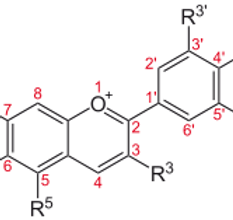Anthocyanins
Anthocyanin
Anthocyanins
Daily Requirement:
Modified DV:
RDA ?:
Adequate Intake ?:
Min Deficiency:
Max Toxicity:
Tolerable UL
Animal:Plant Conv:
Date Discovered:
Short Description:
Although anthocyanins have been shown to have antioxidant properties in vitro, there is no evidence for antioxidant effects in humans after consuming foods rich in anthocyanins. Unlike controlled test-tube conditions, the fate of anthocyanins in vivo shows they are poorly conserved (less than 5%), with most of what is absorbed existing as chemically-modified metabolites that are excreted rapidly
Interpretation:
A growing number of scientific reports suggest that anthocyanins, and anthocyanin-rich berries or derived extracts, exhibit a wide range of protective effects
Some of these effects may be related to inherent associated antioxidant capacity of these compounds, but newly discovered mechanisms of action, such as alteration of gene expression, may be responsible for the observed health benefits
The biomedical properties ascribed to either pure anthocyanins, or to anthocyanin-rich berries or extracts include a large list of beneficial effects on: cardiovascular risk, and cancer prevention.
In dietary-induced hyperlipidemic rats, the intake of chokeberry juice reduced the levels of total plasma cholesterol and of LDL-cholesterol
Few controlled human dietary interventions have investigated the anticholesterolemic and antioxidant effects of anthocyanins or anthocyanin-rich berries, and data are still scarce and inconclusive
In a group of healthy volunteers, a daily intake of a mixed berry juice for a 4-week period led to a decrease in oxidative cell damage and to an increase in the levels of reduced glutathione
However, another study in healthy volunteers consuming blackcurrant juice or an anthocyanin drink (from blackcurrant) for 3 weeks showed no effect on DNA damage markers
In chronic cigarette smokers, the levels of lipid hydroperoxides were reduced by daily consumption of blueberries for several weeks
The chemopreventive properties of dietary polyphenols and specifically of anthocyanins, are a lot more complicated to demonstrate, and much of the evidence accumulated so far is based mostly on in vitro studies and animal cancer models
The consumption of anthocyanins from bilberry reduced the number of intestinal adenomas in an APCM in mouse model.
In rats, berries have been shown to decrease the number of esophageal tumours.
Although berries contain many potentially beneficial anthocyanins, an essential question not yet completely resolved is the bioavailability of these compounds.
The levels of total anthocyanins measured in plasma can vary a lot, and is, in general, very low (in the low nM range, mostly below 0.1 μM).
The proportion of absorbed and excreted anthocyanins is less than 0.1% of the ingested amount, indicating that the metabolic fate of a very high percentage of the ingested anthocyanins has not been yet elucidated.
The microflora in the colon and low stability of anthocyanins at intestinal pH are responsible for the conversion of anthocyanins into more stable small phenolic acids or other unknown molecules
A lot of work remains to be done to elucidate what metabolites and breakdown products originate from the colonic microflora, as well as their tissue distribution.
History & Discovery:
Digestion:
Absorption and Storage:
Important Pathways:
Deficiency Diseases, Detection, Cures:
Proanthocyanidins
Proanthocyanidins are the second most abundant natural phenolics after lignin. They are widespread throughout the plant kingdom, and become part of the human diet upon consumption of fruits (grapes, apples, strawberries, etc.), beans, nuts, cocoa, and wine
Proanthocyanidins have been extensively investigated and they have mainly attracted attention due to their effects on the vascular system, including increase in the antioxidant activity of plasma, decrease of LDL-cholesterol fraction and oxidative stress-derived substances, improvement of endothelium vasodilatation, decrease of blood pressure, maintenance of endothelium function, etc.
These activities have been mainly reported in grape seed extracts and cocoa derived products
The health-beneficial effects of cocoa consumption have been demonstrated along a number of trials in humans
The vast majority of these studies have been carried out with procyanidin-rich cocoa derived foodstuffs
Changes in Blood Pressure After 18 Weeks of Dark or White Chocolate in Relation to Baseline Blood Pressure(Taubert, et al. JAMA. 2007;298:49-60)
44 adults aged 56 through 73 years (24 women, 20 men) with untreated upper-range prehypertension or stage 1 hypertension
Participants were randomly assigned to receive for 18 weeks either 6.3 g (30 kcal) per day of dark chocolate containing 30 mg of polyphenols or matching polyphenol-free white chocolate.




